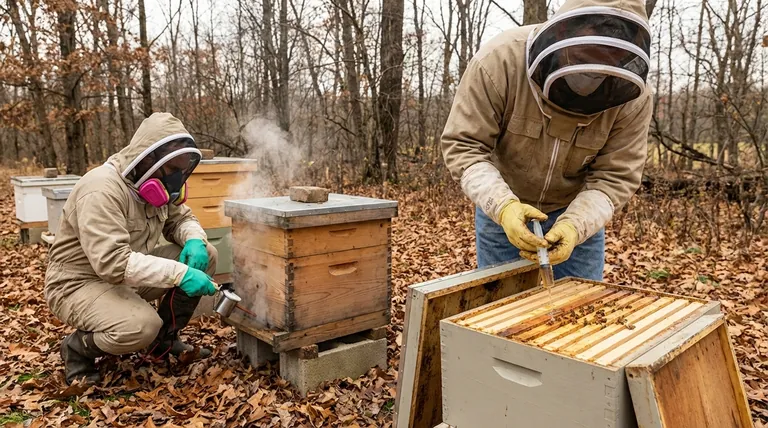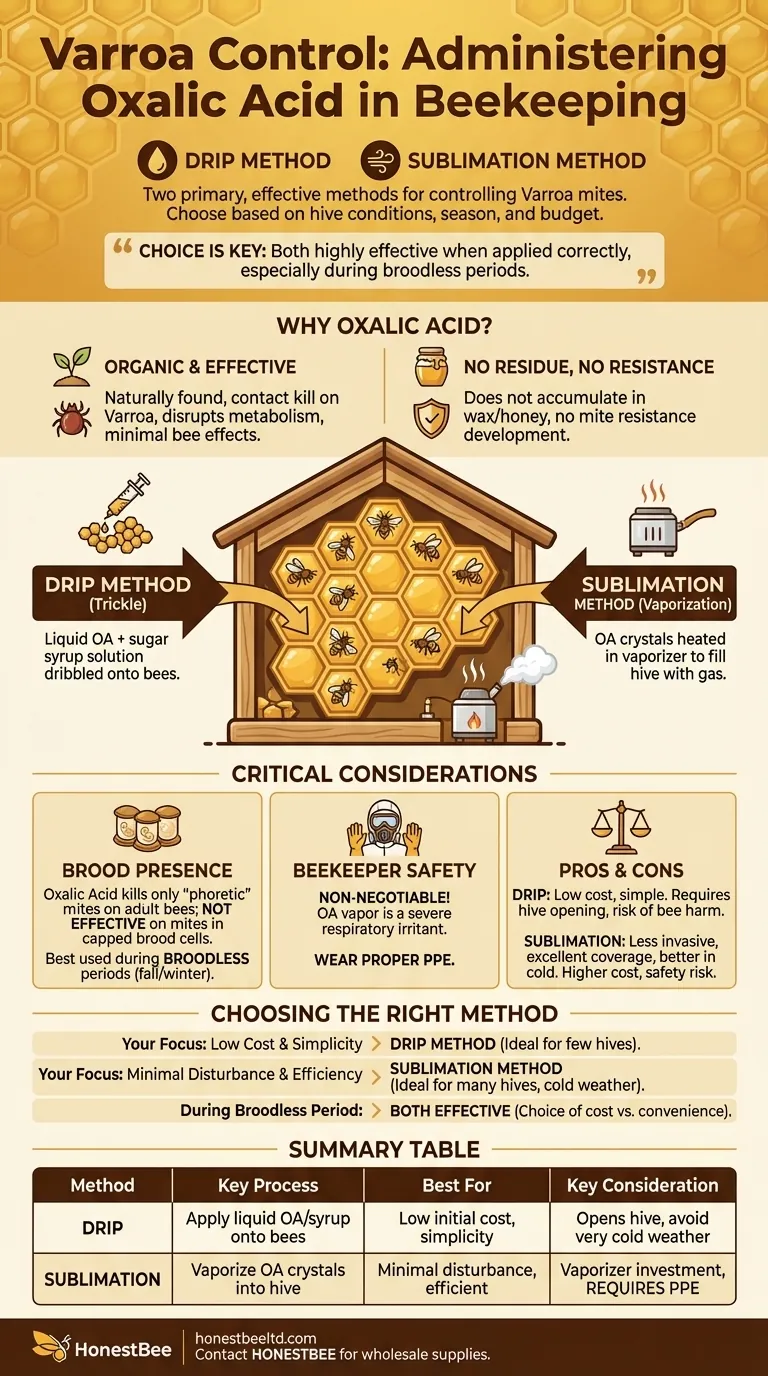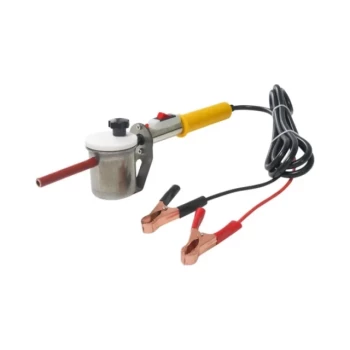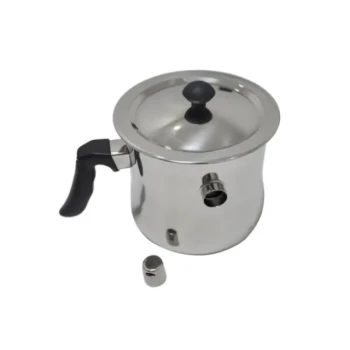In beekeeping, the two primary and most effective methods for administering oxalic acid to control Varroa mites are the drip method and the sublimation method. The drip method involves applying a liquid solution of oxalic acid mixed with sugar syrup directly onto the bees, while sublimation uses a specialized tool to vaporize oxalic acid crystals inside the sealed hive.
Choosing between the drip and sublimation methods is less about which is "better" and more about understanding the specific conditions of your hive, the time of year, and your own equipment budget. Both are highly effective when applied correctly, especially during a broodless period.

Why Choose Oxalic Acid for Varroa Control?
Oxalic acid has become a cornerstone of Integrated Pest Management (IPM) for beekeepers for several key reasons. It offers an effective treatment without the significant drawbacks of older, synthetic chemicals.
An Organic and Effective Solution
Oxalic acid is an organic compound naturally found in many plants, including honey itself. When used for mite treatment, it works on contact.
The acid penetrates the soft tissues of the Varroa mite, primarily through its feet, and disrupts its cellular metabolism, leading to death. When used according to guidelines, it has minimal adverse effects on the bees.
No Residue, No Resistance
Unlike synthetic miticides, oxalic acid does not accumulate in the wax or honey of the hive. This is critical for honey producers and for maintaining the long-term health of the colony's environment.
Furthermore, after decades of use, Varroa mites have not shown any signs of developing resistance to oxalic acid, a common problem with synthetic treatments.
The Core Administration Methods Explained
The choice between dripping and sublimation depends on factors like beekeeper preference, equipment, and weather conditions.
The Drip (or Trickle) Method
This method involves mixing oxalic acid dihydrate crystals with a warm 1:1 sugar syrup solution until fully dissolved.
The resulting liquid is then carefully dribbled or trickled into the spaces between frames, directly onto the clusters of bees. It is a low-cost method but requires opening the hive.
The Sublimation (or Vaporization) Method
This technique uses a special tool called a vaporizer. A pre-measured amount of oxalic acid crystal is placed into the vaporizer, which is then inserted into the hive entrance.
The device heats the crystals, turning them directly into a vapor (sublimation) that fills the hive cavity. This vapor coats all surfaces, including the bees, killing mites on contact without needing to open the hive.
Understanding the Trade-offs and Critical Considerations
Effective treatment requires understanding the limitations and safety protocols associated with oxalic acid.
Brood Presence: The Key Limiting Factor
Oxalic acid does not penetrate capped brood cells. This means it only kills "phoretic" mites—those attached to the bodies of adult bees.
For this reason, oxalic acid treatments are most effective during a broodless period, such as late fall or winter, when nearly all mites are exposed on adult bees.
Drip Method: Pros and Cons
The primary advantage of the drip method is its low cost and simplicity; no special equipment is needed beyond a syringe or measuring device.
However, it requires opening the hive, which can be stressful for the colony in cold weather. There is also a slightly higher risk of harming the bees if the dosage is incorrect or the application is too concentrated.
Sublimation Method: Pros and Cons
Sublimation is less invasive as the hive remains sealed, making it ideal for cold-weather treatments. It provides excellent coverage and is generally considered slightly more effective and gentler on the bees.
The main drawback is the cost of the vaporizer, which can be a significant investment. Crucially, it also presents a higher safety risk to the beekeeper.
Beekeeper Safety is Non-Negotiable
Oxalic acid vapor is a severe respiratory irritant and is dangerous if inhaled. When vaporizing, you must wear proper Personal Protective Equipment (PPE), including a properly-rated respirator mask, safety goggles, and acid-resistant gloves.
Choosing the Right Method for Your Apiary
Your decision should be based on a clear assessment of your goals, budget, and the number of hives you manage.
- If your primary focus is low initial cost and simplicity: The drip method is an accessible and effective starting point, especially for a beekeeper with only a few hives.
- If your primary focus is minimal hive disturbance and efficiency: Sublimation is superior for treating multiple hives quickly and is less stressful for the bees in colder temperatures.
- If you are treating during a broodless period: Both methods are highly effective, making the choice a matter of your preference for cost versus convenience and bee stress.
By understanding these methods and their context, you can effectively manage Varroa mites while safeguarding the long-term health of your colonies.
Summary Table:
| Method | Key Process | Best For | Key Consideration |
|---|---|---|---|
| Drip/Trickle | Apply liquid OA/syrup mix directly onto bees between frames. | Beekeepers prioritizing low initial cost and simplicity. | Requires opening hive; less ideal in very cold weather. |
| Sublimation/Vaporization | Vaporize OA crystals to fill the hive with gas. | Minimizing hive disturbance; efficient treatment of many hives. | Requires vaporizer investment; critical beekeeper PPE required. |
Need Reliable Supplies for Your Varroa Treatment Plan?
HONESTBEE supplies commercial apiaries and beekeeping equipment distributors with the high-quality, wholesale supplies needed for effective oxalic acid treatments. From measuring tools for the drip method to professional-grade equipment, we support the health of your operation.
Contact HONESTBEE today to discuss your wholesale needs and ensure your colonies are protected.
Visual Guide

Related Products
- 12V Bee Mite Removal Evaporator Oxalic Acid Vaporizer for Bee Fumigation Treatment 180W Atomization
- Heavy Duty 12V Oxalic Acid Evaporator Vaporizer for Bee Varroa Mite Treatment Beekeeping Fumigator Atomizer
- Oxalic Acid Vaporizer 12V for Bee Varroa Mite Treatment
- Durable 12V Oxalic Acid Vaporizer for Varroa Mite Treatment Beehive Beekeeping Tool
- Varroa Easy Check Mite Tester Kit Counter Alcohol Wash Jar
People Also Ask
- What is the overall goal of using oxalic acid in late fall for beekeepers? Maximize Winter Survival with a Broodless Treatment
- What are the supposed benefits of fogging oxalic acid over the dribble method? Speed, Coverage, and Bee Safety
- When is the best time to perform Oxalic Acid Vaporization? Maximize Mite Control for Healthy Hives
- What should be done after applying the vapor? A Step-by-Step Guide to Sealing Your Hive
- Can oxalic acid vaporization be used with honey supers on the hive? Ensure Legal Compliance & Honey Safety



















